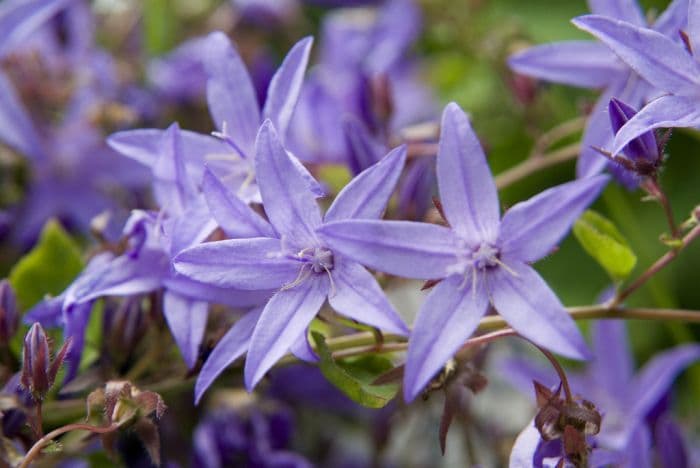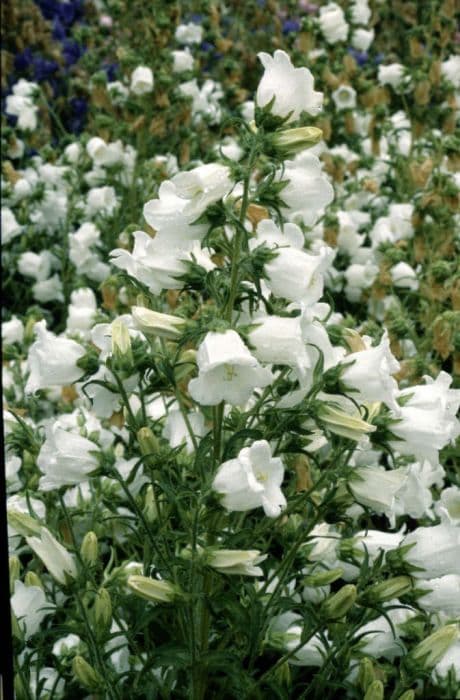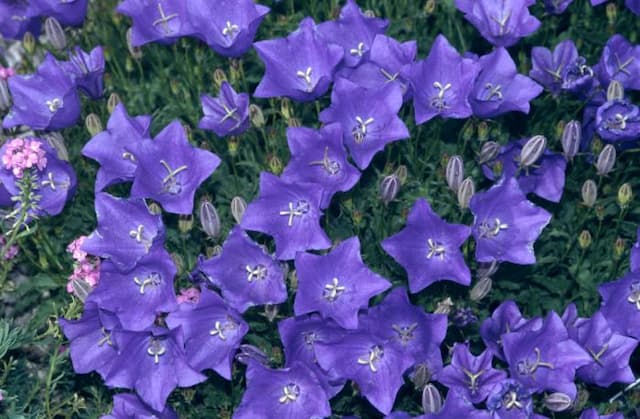Dalmatian Bellflower Campanula portenschlagiana 'Resholdt's Variety'

ABOUT
'Resholdt's Variety' is a cultivar of the bellflower, specifically known for its ornamental charm and enduring blooms. This particular bellflower tends to form a low mound or cushion of foliage. Its leaves are small, heart-shaped, and often have a dark green color which provides a lush background for its flowers. The bell-shaped flowers are a deep blue to violet hue, and they cluster closely together, making a showy and vibrant display. Each flower has five pointed lobes that give it a star-like appearance, adding to its visual appeal. The foliage and flowers together create a rich tapestry of color and texture, making it a popular choice for garden edges, rockeries, and alpine gardens where its charming presence adds beauty without the need for vertical height.
About this plant
 Names
NamesFamily
Campanulaceae.
Synonyms
Dalmatian Bellflower, Adria Bellflower, Wall Bellflower.
Common names
Campanula muralis, Campanula portenschlagiana.
 Toxicity
ToxicityTo humans
Dalmatian bellflower is not known to be toxic to humans. There are no significant toxic effects reported for ingestion of any part of this plant for humans.
To pets
Dalmatian bellflower is generally considered non-toxic to pets, including cats and dogs. There are no prominent symptoms of poisoning associated with the ingestion of this plant by pets. However, individual animals may have different sensitivities, so it's always prudent to monitor for any signs of digestive upset and contact your vet if you have concerns.
 Characteristics
CharacteristicsLife cycle
Perennials
Foliage type
Evergreen
Color of leaves
Green
Flower color
Blue
Height
1 foot [0.3 meters]
Spread
2 feet [0.6 meters]
Plant type
Herb
Hardiness zones
3
Native area
Southeastern Europe
Benefits
 General Benefits
General Benefits- Drought Tolerance: Campanula portenschlagiana 'Resholt's Variety' is relatively drought-tolerant once established, reducing the need for frequent watering.
- Low Maintenance: It requires minimal maintenance, making it ideal for gardeners who prefer plants that don't need constant care.
- Attracts Pollinators: The flowers attract bees and butterflies, which are important for pollination in the garden ecosystem.
- Ground Cover: With its mat-forming habit, it covers the ground effectively, suppressing weeds and minimizing soil erosion.
- Ornamental Appeal: It adds visual interest to the garden with its vibrant purple-blue flowers and lush foliage.
- Rock Gardens: Well-suited for rock gardens and alpine settings due to its growth habit and ability to thrive in rocky soils.
- Containers and Hanging Baskets: Its trailing habit makes it a beautiful addition to containers and hanging baskets.
- Seasonal Interest: Provides a long flowering period, typically from late spring to early fall, offering extended seasonal interest.
- Cold Hardy: The plant is cold hardy, making it suitable for many climates and able to withstand frost.
- Edging and Borders: Perfect for use as edging or in border fronts due to its compact growth and striking color.
 Medical Properties
Medical PropertiesThis plant is not used for medical purposes.
 Air-purifying Qualities
Air-purifying QualitiesThis plant is not specifically known for air purifying qualities.
 Other Uses
Other UsesFloral Arrangements: The Dalmatian Bellflower can be used in floral arrangements as cut flowers, providing a delicate and whimsical touch to bouquets and centerpieces.
Photography Subject: With their picturesque blooms, these plants make an excellent subject for botanical photography and garden portfolios.
Educational Tool: The Dalmatian Bellflower can be used in educational settings such as school gardens to teach children about plant growth habits and perennial lifecycles.
Garden Design: Due to its vibrant purple flowers and ground-covering habit, it's often used in rockeries and alpine gardens for design and aesthetic purposes.
Companion Planting: This plant can be used in companion planting to fill spaces between stepping stones or pavers, providing a living mulch that suppresses weeds.
Culinary Decoration: The edible flowers of the Dalmatian Bellflower can be used to garnish salads and desserts, providing an attractive and edible element to dishes.
Craft Projects: The flowers and foliage can be incorporated into craft projects, such as making floral crowns or decorative wreaths.
Fairy Gardens: The small scale and enchanting look of the Dalmatian Bellflower make it ideal for creating fairy gardens and miniature landscapes.
Potpourri Ingredient: Dried flowers of the Dalmatian Bellflower can be added to potpourri mixes for a subtle, floral fragrance and variety in texture.
Seed Harvesting: Garden enthusiasts can harvest seeds from the Dalmatian Bellflower to propagate new plants or for seed exchange programs.
Interesting Facts
 Feng Shui
Feng ShuiThe Dalmatian Bellflower is not used in Feng Shui practice.
 Zodiac Sign Compitability
Zodiac Sign CompitabilityThe Dalmatian Bellflower is not used in astrology practice.
 Plant Symbolism
Plant Symbolism- Gratitude: The common name for Campanula portenschlagiana 'Resholt's Variety' is Dalmatian Bellflower. Bellflowers are often associated with gratitude due to their delicate and inviting bell shape, which may symbolize a welcoming or thankful gesture.
- Constancy: Dalmatian Bellflower, like other campanula species, is also symbolic of constancy and everlasting love. The perennial nature of this plant reflects the idea of an enduring relationship that stays strong over time.
- Humility: Campanulas in general have a humble appearance, with their heads often nodding or looking down, which can be interpreted as a symbol of humility or modesty.
 Water
WaterFor the Dalmatian Bellflower, it's best to maintain even moisture without allowing the soil to become waterlogged. Water this plant when the top inch of soil feels dry to the touch. Typically, this might be once every week, but this can vary depending on environmental conditions such as temperature and humidity. Aim to provide enough water to moisten the soil throughout the pot, which may be around 16 ounces for a medium-sized container but adjust according to pot size and soil dryness. Avoid overhead watering to keep the foliage dry and prevent possible leaf diseases.
 Light
LightThe best light condition for the Dalmatian Bellflower is a spot that receives partial sun to light shade. The ideal setting would offer morning sunlight with protection from the harsh afternoon sun which can be provided by planting under a tree with dappled sunlight or on an eastern-facing windowsill indoors. Direct, hot sunlight should be avoided as it can scorch the delicate leaves of the plant.
 Temperature
TemperatureDalmatian Bellflower thrives at temperatures between 60 to 75 degrees Fahrenheit, making it an ideal plant for moderate climates. While it can survive temperature dips down to 30 degrees Fahrenheit, it's not frost-hardy and prolonged exposure to cold may damage the plant. Excessive heat above 80 degrees Fahrenheit, especially with high humidity, can also stress the plant and should be avoided.
 Pruning
PruningPrune Dalmatian Bellflower to remove spent flowers and encourage a second bloom. Lightly trim the plant immediately after the first flush of flowers has faded. Doing so not only promotes a tidy appearance but also can stimulate new growth and potentially a secondary flowering period. The best time to prune is in late spring or early summer, directly after the main flowering period has concluded.
 Cleaning
CleaningAs needed
 Soil
SoilThe best soil mix for Dalmatian Bellflower is well-draining, rich in organic material with a pH range of 6.0 to 7.5. A mixture of loam, peat moss, and perlite works well to maintain the appropriate balance of moisture and air around the roots.
 Repotting
RepottingDalmatian Bellflowers should be repotted every two to three years or when they outgrow their current pot. Springtime is ideal for repotting to give the plant time to establish before the growing season.
 Humidity & Misting
Humidity & MistingDalmatian Bellflowers prefer moderate humidity levels but are quite adaptable to different environmental conditions. Maintaining indoor humidity around 50% is generally conducive to healthy growth.
 Suitable locations
Suitable locationsIndoor
Keep in bright indirect light, away from drafts, water when topsoil is dry.
Outdoor
Plant in partial shade or sun, protect from strong winds, and mulch soil.
Hardiness zone
4-9 USDA
 Life cycle
Life cycleThe Dalmatian Bellflower ('Resholdt's Variety') first begins its life cycle as a seed, which, when sown in fertile, well-draining soil and exposed to light, will germinate usually within 2 to 4 weeks. Following sprouting, the seedling grows into a rosette of basal leaves, developing several stems that bear heart-shaped, toothed foliage as it matures. In its flowering stage, typically from early summer to fall, it produces an abundance of bell-shaped, violet-blue flowers which attract pollinators and can lead to self-seeding if not deadheaded. After flowering, if seeds are allowed to fall, the plant can enter a dormancy phase during winter, dying back if subjected to frost, to then regrow from the root system with the return of warmer temperatures in spring. Throughout its life, the plant continues to grow and spread, forming dense, mat-like patches that can be propagated by division every few years to maintain vigor and manage its spread. This perennial plant can live several years, completing this cycle annually, although its lifespan can be extended or shortened depending on cultural conditions and care.
 Propogation
PropogationPropogation time
Spring to early summer
Campanula portenschlagiana 'Resholt's Variety', commonly known as Dalmatian Bellflower, is often propagated by division, which is the most popular method for this plant. Propagation by division is ideally done in the spring, just as the plants begin to show new growth. To propagate by division, carefully dig up the entire plant and gently separate it into smaller clumps, ensuring that each new section has a good amount of roots attached. These divisions can then be immediately replanted in well-draining soil, ideally in a location that receives partial shade to full sun. Water the newly planted divisions thoroughly to help establish them. Over time, these new clumps will grow and fill in the space, providing a charming display of bell-shaped flowers.









